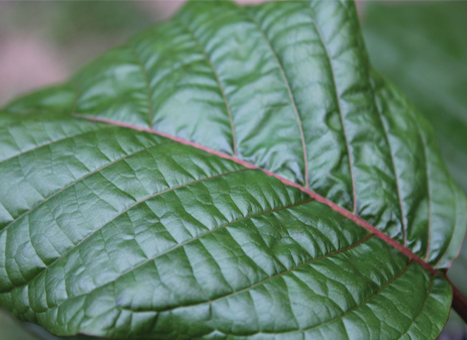Branches bursting with secrets
While mitragynine, 7-hydroxymitragynine and a few dozen other alkaloids make up the bulk of the 57 phytochemicals that have been isolated from kratom leaves, the plants contain a panoply of currently unidentified compounds and metabolites.
“The average plant leaf is somewhere between 35,000 and 50,000 distinct phytochemicals, and we really can identify about 1,000 if we’re lucky,” says Susan Murch, a chemist at the University of British Columbia. “You’re looking at a minimum 34,000 unknowns. In your glass of merlot, you’re looking at 7,000 unknowns; in your cup of coffee, over about 6,800 unknowns.”
 The leaf of Mitragyna speciosa contains at least 34,000 unknown phytochemicals.thorporre/Wikimedia Commons
The leaf of Mitragyna speciosa contains at least 34,000 unknown phytochemicals.thorporre/Wikimedia Commons
Identifying these unknown compounds and mapping their enzymatic relationships to one another by use of mathematical equations is known as metabolomics; each study can take up to three to four years due to its scale. “You do a very small mass spec analysis, and then you spend a year mining data. It’s a massive bioinformatics program,” says Murch.
Murch recently published a literature review in the Journal of Ethnopharmacology that detailed the history and chemistry of kratom and its sister species in Western medical literature with Web of Science, Google Scholar, the Royal Museum for Central Africa, the Internet Archive, the Hathi Trust and the Biodiversity Heritage Library.
Murch and her collaborator Paula N. Brown are hoping to get a metabolomics study involving kratom up and going within the next few years. “There are no metabolomics studies out there that really are definitive in terms of the different varieties, the different strains, the different things people are using,” she says.
Identifying the thousands of unknown metabolites, or intermediary components, within kratom leaves will be essential to understanding how the plant products are differently processed by populations across the globe.
“Kratom is traditionally used by a fairly specific population of Vietnam, Thailand and Southeast Asia, and so we don’t know about its nutrigenomics effects,” says Murch. “Assuming that a population in Southeast Asia will respond the same as a population anywhere else in the world is a bit of a leap of faith.”
Enjoy reading ASBMB Today?
Become a member to receive the print edition four times a year and the digital edition monthly.
Learn moreGet the latest from ASBMB Today
Enter your email address, and we’ll send you a weekly email with recent articles, interviews and more.
Latest in Science
Science highlights or most popular articles

AI unlocks the hidden grammar of gene regulation
Using fruit flies and artificial intelligence, Julia Zeitlinger’s lab is decoding genome patterns — revealing how transcription factors and nucleosomes control gene expression, pushing biology toward faster, more precise discoveries.

Zebrafish model links low omega-3s to eye abnormalities
Researchers at the University of Colorado Anschutz developed a zebrafish model to show that low maternal docosahexaenoic acid can disrupt embryo eye development and immune gene expression, offering a tool to study nutrition in neurodevelopment.

Top reviewers at ASBMB journals
Editors recognize the heavy-lifters and rising stars during Peer Review Week.

Teaching AI to listen
A computational medicine graduate student reflects on building natural language processing tools that extract meaning from messy clinical notes — transforming how we identify genetic risk while redefining what it means to listen in science.

Early lipid changes drive retinal degeneration in Zellweger spectrum disorder
Lipid profiling in a rare disease mouse model reveals metabolic shifts and inflammation in the retinal pigment epithelium — offering promising biomarker leads to combat blindness.

How sugars shape Marfan syndrome
Research from the University of Georgia shows that Marfan syndrome–associated fibrillin-1 mutations disrupt O glycosylation, revealing unexpected changes that may alter the protein's function in the extracellular matrix.

